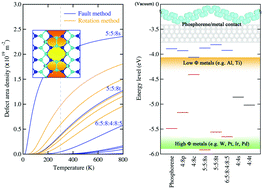Remarkably low-energy one-dimensional fault line defects in single-layered phosphorene
Abstract
Systematic engineering of atomic-scale low-dimensional defects in two-dimensional nanomaterials is a promising method to modulate the electronic properties of these nanomaterials. Defects at interfaces such as grain boundaries and line defects can often be detrimental to technologically important nanodevice operations and thus a fundamental understanding of how such one-dimensional defects may have an influence on their physio-chemical properties is pivotal for optimizing their device performance. Of late, two-dimensional phosphorene has attracted much attention due to its high carrier mobility and good mechanical flexibility. In this study, using density-functional theory, we have investigated the temperature-dependent energetics and electronic structure of single-layered phosphorene with various fault line defects. We have generated different line defect models based on a fault method, rather than the conventional rotation method. This has allowed us to study and identify new low-energy line defects, and we show how these low-energy line defects could well modulate the electronic band gap energies of single-layered two-dimensional phosphorene – offering a range of metallic to semiconducting properties in these newly proposed low-energy line defects in phosphorene.


 Please wait while we load your content...
Please wait while we load your content...